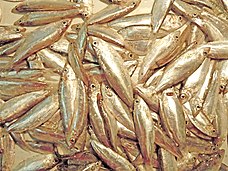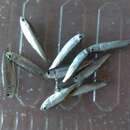Diagnostic Description
provided by FAO species catalogs
Body moderately deep, its depth about 21 to 27% of standard length; head short and wide, inter-orbital width at least 17.5% of standard length; belly sharply keeled, with 24 to 29 scutes. Gillrakers 49 to 62. Pectoral fin tips pointed.
Meric, (1984 growth, reproduction, distribution).
- bibliographic citation
- FAO Species catalogue Vol. 7. Clupeoid fishes of the world. (Suborder CLUPEOIDEI) An annotated and illustrated catalogue of the herrings, sardines, pilchards, sprats, anchovies and wolf-herrings. Part 1. Chirocentridae, Clupeidae and Pristigasteridae.Whitehead, P.J.P. 1985. FAO Fish. Synop., (125)Vol.7 Pt. 1:303 p.
- author
- Food and Agriculture Organization of the UN
Distribution
provided by FAO species catalogs
Black Sea (northwestern parts), Sea of Azov and Caspian Sea, also most of the affluent rivers of the area, reaching as far as 60 km inland.Also, Lake Palaeostomi (Bulgaria)and in Bay of Feodosiya (Romania), also Lake Apolyont (Turkey).
- bibliographic citation
- FAO Species catalogue Vol. 7. Clupeoid fishes of the world. (Suborder CLUPEOIDEI) An annotated and illustrated catalogue of the herrings, sardines, pilchards, sprats, anchovies and wolf-herrings. Part 1. Chirocentridae, Clupeidae and Pristigasteridae.Whitehead, P.J.P. 1985. FAO Fish. Synop., (125)Vol.7 Pt. 1:303 p.
- author
- Food and Agriculture Organization of the UN
Size
provided by FAO species catalogs
To 14.5 cm standard length, usually to 10 cm.
- bibliographic citation
- FAO Species catalogue Vol. 7. Clupeoid fishes of the world. (Suborder CLUPEOIDEI) An annotated and illustrated catalogue of the herrings, sardines, pilchards, sprats, anchovies and wolf-herrings. Part 1. Chirocentridae, Clupeidae and Pristigasteridae.Whitehead, P.J.P. 1985. FAO Fish. Synop., (125)Vol.7 Pt. 1:303 p.
- author
- Food and Agriculture Organization of the UN
Brief Summary
provided by FAO species catalogs
Pelagic,euryhaline, essentially a brackishwater species (tolerating sali nities up to 34%o), but with semi-anadromous and purely freshwater forms in rivers and lakes; migratory between winter or autumn feeding and summer spawning grounds.Feeds on zooplankton. Breeds in early summer in Sea of Azov (peak in May), and from about May in the lower reaches of rivers (Dneiper, Dneister).
- bibliographic citation
- FAO Species catalogue Vol. 7. Clupeoid fishes of the world. (Suborder CLUPEOIDEI) An annotated and illustrated catalogue of the herrings, sardines, pilchards, sprats, anchovies and wolf-herrings. Part 1. Chirocentridae, Clupeidae and Pristigasteridae.Whitehead, P.J.P. 1985. FAO Fish. Synop., (125)Vol.7 Pt. 1:303 p.
- author
- Food and Agriculture Organization of the UN
Benefits
provided by FAO species catalogs
Of major importance in Sea of Azov (one of the top commercial fishes); stocks depleted in southern part of Caspian Sea (Coad, 1980:71 - C. delicatula). The total catch in 1983 was 396 731 t. The total catch reported for this species to FAO for 1999 was 180 687 t. The countries with the largest catches were Russian Federation (152 934 t) and Ukraine (9 992 t).
- bibliographic citation
- FAO Species catalogue Vol. 7. Clupeoid fishes of the world. (Suborder CLUPEOIDEI) An annotated and illustrated catalogue of the herrings, sardines, pilchards, sprats, anchovies and wolf-herrings. Part 1. Chirocentridae, Clupeidae and Pristigasteridae.Whitehead, P.J.P. 1985. FAO Fish. Synop., (125)Vol.7 Pt. 1:303 p.
- author
- Food and Agriculture Organization of the UN
Diagnostic Description
provided by Fishbase
Head short and wide; belly sharply keeled, with 24 to 29 scutes; pectoral fin tips pointed; last 2 anal fin rays enlarged; pterotic bulla absent; no notch at the center of the upper jaw. Based on pelvic and pectoral fin length, Svetovidov (1952 and 1963) recognized 2 subspecies: C. cultriventris cultriventris with longer pectoral and pelvic fins compared to that of C. cultriventris caspia.
- Recorder
- Crispina B. Binohlan
Migration
provided by Fishbase
Anadromous. Fish that ascend rivers to spawn, as salmon and hilsa do. Sub-division of diadromous. Migrations should be cyclical and predictable and cover more than 100 km.
- Recorder
- Crispina B. Binohlan
Morphology
provided by Fishbase
Dorsal spines (total): 0; Dorsal soft rays (total): 13 - 21; Analspines: 0; Analsoft rays: 12 - 23
- Recorder
- Crispina B. Binohlan
Trophic Strategy
provided by Fishbase
Pelagic, euryhaline, essentially a brackishwater species (tolerating salinities up to 34 o/oo), but with semi-anadromous and pure water forms in rivers and lakes; migratory between winter or autumn feeding and summer spawning grounds.
- Recorder
- Crispina B. Binohlan
Biology
provided by Fishbase
Essentially a brackish water species but tolerating salinities up to 34 ppt and with semi-anadromous and purely freshwater forms in rivers and lakes. Forms schools. Migratory between winter or autumn feeding and summer spawning grounds. Feeds on zooplankton (Ref. 188); crustaceans such as copepods and cladocerans (Ref. 59043). Breeds in early summer in the Sea of Azov with a peak in May, and from about May in the lower reaches of rivers (e.g. Dneiper and Dneister) (Ref. 188). Eggs are pelagic (Ref. 59043).
- Recorder
- Crispina B. Binohlan
Importance
provided by Fishbase
fisheries: highly commercial; price category: high; price reliability: reliable: based on ex-vessel price for this species
- Recorder
- Crispina B. Binohlan
Black Sea sprat
provided by wikipedia EN
The Black Sea sprat, Clupeonella cultriventris, is a small fish of the herring family, Clupeidae. It is found in the Black Sea and Sea of Azov and rivers of its basins: Danube, Dnister, Dnipro (Ukraine), Southern Bug, Don, Kuban. It has white-grey flesh and silver-grey scales. A typical size is 10 cm (maximum 15 cm)[3] The life span is of up to 5 years.[3] The peak of its spawning is in April and it can be found in enormous shoals in sea-shores, filled all-round coastal shallows, moving quickly back into the sea at a depth of 6–30 metres. Used for food; it has around 12% fat in flesh.
It is one of the most abundant fishes in the Sea of Azov. It is important prey for other fishes, particularly the pikeperch.[4]
The Caspian tyulka Clupeonella caspia has been long considered a subspecies of C. cultriventris, C. cultriventris caspia, and a common name "Black and Caspian Sea sprat" was then applied to the whole.[5][3]
See also
References

- license
- cc-by-sa-3.0
- copyright
- Wikipedia authors and editors
Black Sea sprat: Brief Summary
provided by wikipedia EN
The Black Sea sprat, Clupeonella cultriventris, is a small fish of the herring family, Clupeidae. It is found in the Black Sea and Sea of Azov and rivers of its basins: Danube, Dnister, Dnipro (Ukraine), Southern Bug, Don, Kuban. It has white-grey flesh and silver-grey scales. A typical size is 10 cm (maximum 15 cm) The life span is of up to 5 years. The peak of its spawning is in April and it can be found in enormous shoals in sea-shores, filled all-round coastal shallows, moving quickly back into the sea at a depth of 6–30 metres. Used for food; it has around 12% fat in flesh.
It is one of the most abundant fishes in the Sea of Azov. It is important prey for other fishes, particularly the pikeperch.
The Caspian tyulka Clupeonella caspia has been long considered a subspecies of C. cultriventris, C. cultriventris caspia, and a common name "Black and Caspian Sea sprat" was then applied to the whole.

- license
- cc-by-sa-3.0
- copyright
- Wikipedia authors and editors


